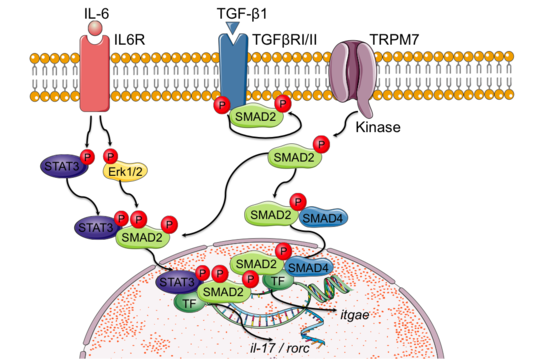Zierler Lab "Ion Channels in Immune Function"
Head: Prof. Dr. Susanna Zierler
Group members:
Technical Assistant: Lisa Alker, M.Sc.; Ph.D. students: Katharina Jacob; Max Lechner (SFB 152) MD Student: Kilian Hölting, (FoeFoLe); Marco Fraticelli (FoFoLe)
Ion Channels in Immunity
Our research focuses on the importance of ion channels and the regulation of nutrients such as calcium (Ca2+) and magnesium (Mg2+) in immune cells. Particularly, we are interested in the melastatin-like “transient receptor potential” (TRP) ion channel, TRPM7, and its enzymatic domain, which encodes an atypical alpha-kinase. This Mg2+ and Ca2+ conducting enzyme-coupled ion channel is expressed in all eukaryotic cells and regulates fundamental cellular processes such as growth, proliferation, migration, differentiation and survival. Knock down of TRPM7 causes growth arrest and eventually results in cell death [1,2].
Given the role of TRPM7 in cell proliferation, we were looking for pharmacological tools and experimental therapeutics for this target. Screening a marine-derived extract library, we identified and characterized a specific TRPM7 blocker, waixenicin A, isolated from a Hawaiian soft coral. Chemical analogs will be tested for possible use in anti-cancer treatment [3].
Considering that low Mg2+ levels have been linked to memory decline, neurodegenerative diseases, decrease in muscle performance, certain cancers and allergic reactions, it is of critical importance to further identify the mechanisms regulating the availability of this ion. Mice lacking the kinase part of this unique protein develop hypomagnesemia [4]. We demonstrated an important role of TRPM7 kinase in mast cell secretion, linking Mg2+ deficiency to allergic hypersensitivity and histamine release [5].
Since disruption of these pathways can result in immunodeficiencies, autoimmune diseases or cancer, it is important to further understand these signaling cascades. With the acquired knowledge, we intend to uncover complex signaling pathways of immune responses and possibly find new targets for immune therapies. We will use an innovative approach combining cell and molecular biological methods, as well as electrophysiological techniques in different mouse models.
TRPM7 regulates immune homeostasis
Our most recent studies indicate a regulatory role of TRPM7 kinase activity in homeostasis of the immune system. Kinase-deficient mice display altered cytokine expression as well as reduced numbers of intraepithelial lymphocytes (IELs) in the gut. Thus, these mice are protected from the development of acute Graft-versus-Host Disease (GVHD) in a respective mouse model (Fig. 1D). Moreover, we demonstrated that the differentiation of pro-inflammatory Th17 cells was strongly reduced, while regulatory T cells (Tregs) developed normally in kinase-deficient animals (Fig. 1B, C). In vitro we deciphered the molecular mechanism behind this phenotype and identified SMAD2 as a first novel native TRPM7 kinase substrate (sh. Fig. 1) [6, 7].
Figure 1: TRPM7 kinase regulates immune system homeostasis and GVHD via phosphorylation of SMAD2. Molecular mechanism of TRPM7 kinase-mediated SMAD2-dependent gene expression. TGF-β-receptor stimulation (TGF-βRI/II) results in the recruitment of SMAD2 to the plasma membrane PM). Once it is at the PM, in T cells SMAD2 is phosphorylated by the TRPM7 kinase, enabling its translocation into the nucleus, where it promotes the transcription of itgae (CD103), il-17 and rorc.
Literature
[1] Nadler M J, Hermosura M C, Inabe K, Perraud A , Zhu Q., Stokes A. J., Kurosaki T., Kinet J. P., Penner R, Scharenberg A M, Fleig A; Nature (2001).
[2] Schmitz C, Perraud A L, Johnson C O, Inabe K, Smith M K, Penner R, Kurosaki T, Fleig A, Scharenberg A M; Cell (2003)
[3] Zierler S, Yao G, Zhang Z, Kuo C, Pörzgen P, Penner R, Horgan D, Fleig A; JBC, 286 (2011)
[4]Ryazanova L V, Rondon L J, Zierler S, Hu Z, Galli J, Yamaguchi T P, Mazur A, Fleig A, Ryazanov A G; Nature Communications (2010).
[5] Zierler S, Sumoza-Toledo A, Suzuki S, Duill FO, Ryazanova LV, Penner R, Ryazanov AG, Fleig A TRPM7 kinase activity regulates murine mast cell degranulation; The Journal of Physiology (2016)
[6] Romagnani A, Vettore V, Rezzonico-Jost T, Hampe S, Rottoli E, Nadolni W, Perotti M, Meier MA, Hermanns C, Geiger S, Wennemuth G, Recordati C, Matsushita M, Muehlich S, Proietti M, Chubanov V, Gudermann T, Grassi F, Zierler S; TRPM7 kinase activity is essential for T cell colonization and alloreactivity in the gut. Nature Communications (2017)
[7] Nadolni W & Zierler S; The Channel-Kinase TRPM7 as Novel Regulator of Immune System Homeostasis. Cells (2018)
Funding
Current Projects
2018 – 2022 DFG CRC/TRR-152 (2) P14; TR(I)Ps to Homeostasis; The kinase-coupled TRPM7-channel as regulator of immune system homeostasis
2018 – 2020 FöFoLe, LMU (Kilian Hölting), TRPM7-Kanal und -Kinase vermittelte Signalkaskaden - von der Membran zum Kern
Finished Projects
2014 – 2018 DFG CRC/TRR-152 (1) P14; TR(I)Ps to Homeostasis; The kinase-coupled TRPM7-channel as regulator of immune system homeostasis
2012 – 2016 Marie Curie Stiftung, FP7-PEOPLE-20112-CIG no. 322 185, REA, Brüssel, Role of enzyme-coupled TRP channels in immune cells
2012 – 2014 ERA.Net RUS, FPY ERA, FP7, STProjets-184, BMBF, Bonn, TRPM7 in regulation of T cell subsets and purinergic signaling
03/2012 FöFoLe, LMU (Dorothea Lewitz), Rolle von enzymgekoppelten Ionenkanälen bei der Aktivierung und Differenzierung von T-Zellen
Former Group Members
PhD Students: Valentina Vettore; MS Students: Stephanie Hunger, B.Sc., Maximiliane Kronberger, B.Sc., Wiebke Nadolni, M.Sc., Jan Weber, M.Sc.; Sarah Hampe
MD Students: Dorothea Lewitz (FoeFoLe), Petro Bannout, Interns: Fionán Ó Dúill, B.Sc., Tobias Klötzer, B.Sc.; Christina Moser, B.Sc., Maximiliane Kronberger, B.Sc., Moritz Pendzialek, B.Sc., Ulrike Künzel, B.Sc., Annika Schneider, B.Sc., Wiebke Nadolni, B.Sc., Jan Weber, B.Sc.; Visiting Scientist: Eva M. Grössinger, Dr. rer. nat.
Laura Fraticelli, B.Sc.


